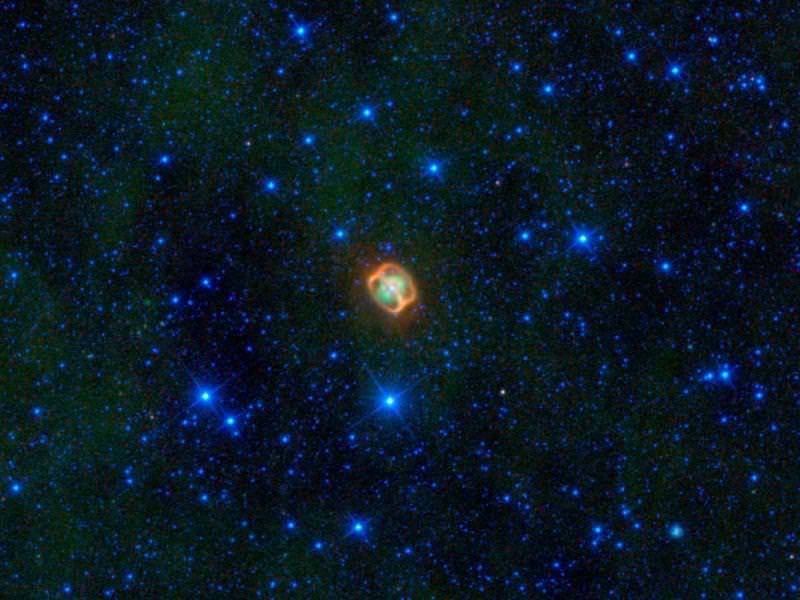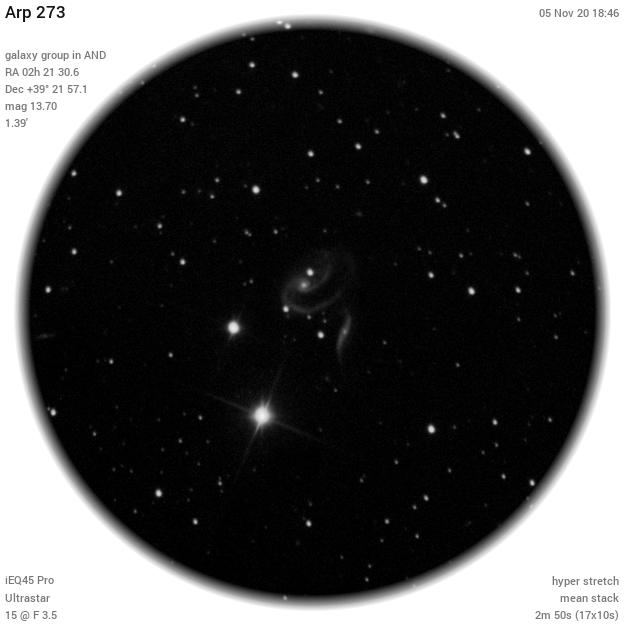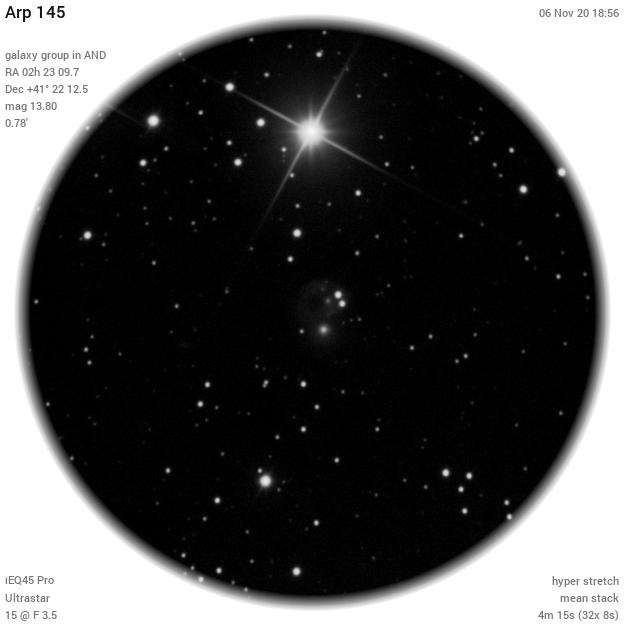
Mike JW
-
Posts
1,229 -
Joined
-
Last visited
Content Type
Profiles
Forums
Gallery
Events
Blogs
Posts posted by Mike JW
-
-
Hi Bill,
The image has fired me up for a visit sometime. Apparently the orbit of the companion is very eccentric and takes about nine years to complete one orbit. This is the longest known orbital period for a PN and confirms that long orbital period binaries can form PNs. One article back in 2003 thought the orbital period was just 10 days.
Below is the WISE image.
Mike

-
 3
3
-
-
Agree that it is a lovely sight. Dead centre of your fov is Leda 2180614 = mag 18.8 (according to ST4),
Mike
-
 1
1
-
-
ARP 273 - in Andromeda. The Hubble mages of this pair are stunning. The big one (UGC 1810) is 200,000+ lyrs across and the data suggests its companion (UGC 1813) dived straight through it creating the ring effect as it did so.
ARP 145 in Andromeda. This pair share the designation UGC 1840. The lower galaxy (lenticular) dived straight through the upper one to create the ring. Just to the right of the ring is the fuzz of the galaxy core.
-
 5
5
-
-
5 hours ago, callump said:
Hi Mike,
what sort of Dob and drive system do you have?
Thanks,
Callum15" Truss Dob with encoders and servo cat motors, using Nexus. Much prefer Nexus to Argo Navis.
Mike
-
 1
1
-
-
Hi David,
A 12 inch Dob is a great size for DSOs. My suggestion would be enjoy using it visually to get to know the sky. Go for galaxies brighter than mag 12 and then ponder using the EEVA technique to observe.
I had a 12 ", then 15" and finally a 20" Dob and enjoyed 20 years of visual observing but in the end I ran out of targets that satisfied me. Even in the 20" the sort of observations you see here in the EEVA section are way beyond even a 20" scope
I use a Dob for EEVA but it is fully driven as well as a SCT.
Mike
-
 1
1
-
-
-
40 minutes ago, Marvin Jenkins said:
Mike JW, any idea what is going on with NGC 7270? (WBL 680) Looks like two galaxies colliding, seems there are two core’s. Is there any other info on this? I will have my own dig and see what comes up.
Great work as always, keep it coming. Frankly I have no idea how you are all doing it. Dr Zarkov cloud gun?
Marvin
Hi Marvin, I looked at Aladin/NED data for 7270 - the extra blobs are stars and not two cores. I wondered like you at first.
Martin - WBL685 - you should see the Aladin/NED chart for that area - so many X marks indicating numerous objects. Love the WBL 685 image and the black surround.
Tomorrow I will spend time having a good peruse of your WBL 085.
Mike
-
1 hour ago, Martin Meredith said:
Here's a recent observation of Arp 282 to throw into the mix. I added about 1 minute in each of RGB to a 2 minute luminosity 'base' as I am starting to do when I see possibly interesting stars in the field.
I just noticed that the bright star at the right is a double (you can make out the secondary in line with the spikes to the SW). It is known as HO 623 (not sure who HO was). The primary is spectral type K2III and mag 7.2 while the secondary is just over 9 arcsecs away and has a magnitude of 12.3. It is separated in all three of our shots.
I love the delicate wound-up arms of the spiral NGC 160
HO = G. W. Hough. I had not thought to check out the double - nice one Martin. (I use to observe doubles but this one was not on my lists as the companion B was just out of reach of my scope.) Thanks for your post on Arp 282. Mike
-
13 minutes ago, Martin Meredith said:
I think severe contrast stretching is definitely EEVA (at least potentially; I do it all the time). As for long exposures, I don't think anyone really minds here so long as the intent is observation/astrophysics rather than AP. I've gone nearly up to an hour trying (and failing) to spot z=6 quasars. I'm certainly interesting in hearing about your approach.
Martin
Agree = if the intent is observation, then that is what the EEVA threads are about. Mike
-
On October 27 Callum posted Arp 282 to which I replied I hoped to re-visit. From the pair head towards 5 o clock and you pass a faint fuzz (mag 18) - also on Callum's shot. There are two other fuzz spots (mag 17 galaxies).
Also in Callum's shot was NGC 160 and what a lovely sight that is - classed as SO-a, with UGC 354 (NGC 162) above the bright star and Leda 212552 below NGC 160 (almost mag 17)


Mike
-
 3
3
-
-
WBL 685 in Pegasus.
This group has 6 members. Top is NGC 7342 is a face on barred spiral. Over to the left is NGC 7345 - edge on spiral. There are four more members but the question is, which four? On the second shot I have indicated the members with red lines. The other lines (yellow but look off white) indicate other galaxies, which when I checked in Aladin (NED data) they have similar redshifts suggesting they too are part of this group.


WBL 680 in Pegasus has just three members NGC 7270, (right), NGC 7275 (left) and NGC 7271 (straight down from 7270). The two other obvious galaxies - no info found, so they could be part of this group or not.

WBL 687 in Pegasus - another three member group and what a lovely spiral to observe - UGC 12193 - a loosely wound spiral - SBc, some 150,000 lyrs across. Sky Tools 4 suggests it is interacting with another galaxy but I cannot find any papers on it.

Mike
-
 2
2
-
-
SHK 176 in Andromeda. I called this group - 'you must be joking'. Take a look at the full frame shot - I had to triple check that I was in the right area. There are 10 members - oh yeah!. Look to the left of the central bright star - surely not!
Close up - it took me awhile to find the best setting to make them all obvious. Even then the 10th member is only just visible - dead centre - a faint elongated fuzz which NED gives as mag 18.5 and no further info. I really needed to collect some more subs but cloud was approaching.

Mike
-
 4
4
-
-
Thanks Marv.
As you realise, there is a group of us that so enjoy using the EEVA technique to 'observe' followed by finding out more information. Personally I see little observational value in simply posting an image with no comment as to the object. I shall look forward to you posting in this forum. Ask for guidance if you need any help.
Cheers,
Mike
-
 1
1
-
-
HICKSON 10 in Andromeda
It has been awhile since we have had a Hickson post. So to that end I re-visited Hickson 10 and in the excitement of the view I only just included component B (at the top). I was enjoying the diffraction spikes (again!).
The galaxy in the centre NGC 536 and NGC 542 below it are both spirals. Above is NGC 531 is a lenticular and the fourth member (at the top - NGC 529) is an elliptical. NGC 536 - the bar can be clearly seen. Also what interests me is that there is one obvious, main arm extending along way upwards NGC 529, the opposite is well defined near the bar and then peters out. High resolution images show this arm forming part of a ring around the central core (picked up the ring). Beyond the central area is a halo of stars.
Just sneaking in at bottom left is PGC 5421 - mag 15.8.
-
 1
1
-
-
Hi Achim,
I am trying a new approach to chalk/pastel sketches. I am producing large sketches as it is easier to get the details and the feel of the crater(s). I am also worrying less about accuracy and going for the 'feel' of the view/crater. The size of my sketch for Petavius would equate to probably x500 or more magnification which is of course not practical in our unsteady skies.
Mike
-
As you say, all good fun.
I think top right, the fuzz ball is PGC 5784 - mag 16 ish. Up and to the laft a bit is Leda 1980192 - 16.9 ish.
Mike
-
Hi Martin,
The suspect galaxy near the star - NED gives it as an Infra-red source which I assume is therefore a galaxy?
As to smaller pixels - Ultrastar?
Mike
-
2/11/20 - I was wandering along the terminator when Petavius stopped me in my tracks - unbelievable view as the sun was setting over this well known crater. The low sunlight revealed details that are not normally obvious when viewed with the sun higher in the sky. My standard idea of a crater is ring of terraced walls, falling to a flat floor with a central peak(s). I know this not to be true but mostly that is the impression we get once craters are away from the terminator.
Details for Petavius and its companion Wrottesley are more or less as I noted at the eyepiece. The rest is artistic licence - ish.
North is up.
1. note the central peak appears to lie on a ridge, with several minor peaks gradually getting lower to the south (they get smaller and fainter). Ridges seem to descend from these peaks in a curving southward direction.
2. the most northern of these curved ridges would seem to coincide with the well known rille that runs from the central area
3. the fact that the central area was still in some sort of daylight but the rest of the crater floor is darker confirms that there is a large part of of the crater floor where the central peaks are higher than the crater floor nearer to the rim.
4. at the southern end (west side), the crater wall would appear to be double and the inner wall had at least four major peaks, maybe more.
5. on the east side the black of the terminator has broken through to the inner part of the crater, implying this is a low point in the vast crater wall.
Why do I enjoy sketching? Not just for the art but because when we look carefully we see so much more and then we discover/learn so much as well.
Mike
-
 6
6
-
-
Dedication always brings a reward - great idea. Mike
-
 1
1
-
-
VV 1985 in Pegasus is classified as 'N' (multiple) - you could fool me on this one! but take a look at the close up shot and all is revealed or is it?
Close up - to the right of the main nucleus is a hint of a second nucleus so this would make it a pair in contact (PK) or pair coalescence (PC) but to be classed as 'N' there needs to be a third member but I cannot spot it.

VV 1987 - this is also a multiple and faint. It is the faint grey fuzz in the centre - only in high resolution images can the components be identified. My close up does not help either. However look over to the right and there lurks a galactic mess - MCG 3-60-7 - Irr (totally agree that it is seriously irregular) - see my close up - could be three galaxies doing a close dance, certainly two.


Mike
-
 3
3
-
-
SHK 225 in Pegasus. Look carefully and you will this group in the centre. This is a small group with just 8 members.
Close up - these guys are faint. The fuzz at top right is PGC 1953277 - mag 17.6, (not part of the group). Drop straight down and a touch left, just below the centre is a fuzz with extensions - PGC 1952668, mag 18.6.(number 5 in the SHK group). The remaining 7 members are distributed around the centre of the image (not the bright star).

SHK 340 - in Pisces. This SHK is slightly unusual because there are two distinct groupings near to each other. The 13 members of the obvious group are to the right of the fov. The obvious fuzz spots are all PGC, mag 17 galaxies (5 in total) with the remaining 7 in the area. I appear to have picked up other fainter galaxies (or very faint stars) as well in this area.
To the left of the fov can be seen a distorted circle of galaxies and a bright-ish star.

Mike
-
 2
2
-
-
ARP 98 in Triangulum, is not one to write home about. It is classified as 'Spiral with elliptical companion on its arm'. Last time I visited this interacting pair I used the C11 and struggled to see much, so last night I pointed the 15 at it. At mag 15 it certainly is a challenge and despite stacking for over 6 minutes there is not a wealth of detail on show. The main galaxy is classed as Sbc and the companion lies at the end of a 170,000 lyr bridge of stars. The pair lie somewhere in the region of 550 million lyrs away (figures vary).
Mike

-
 3
3
-
-
Hi Marvin,
Below is Campbell's Hydrogen Star - I used my 15" Dob with the Ultrastar and did 19 x 5sec subs.


Mike
-
I have scanned them all into a document as a record of my journey. The best ones I have put into folder, along with other DSO sketches. Mike

































Chalk-/charcoal sketch of Orientale Basin
in Sketching
Posted
Hi Achim,
I share the excitement at seeing the Orientale basin. I saw it earlier on this year and like you had to do a chalk/charcoal sketch but unlike you there is no way I have the skill to sketch at the eyepiece. For some reason I did not post it, probably got side - tracked on my EEVA targets. So here is my take below.
Plenty of artistic licence. I was thrilled to see the the two concentric mountain ranges and as you know it is your work that has inspired me to give the chalk/charcoal technique a go.
Mike